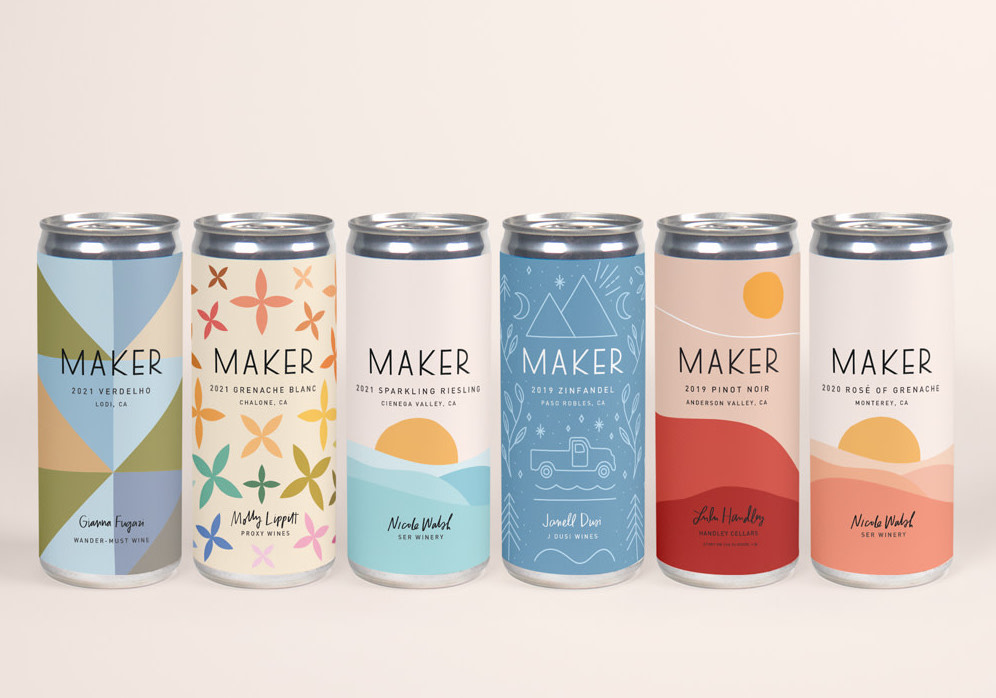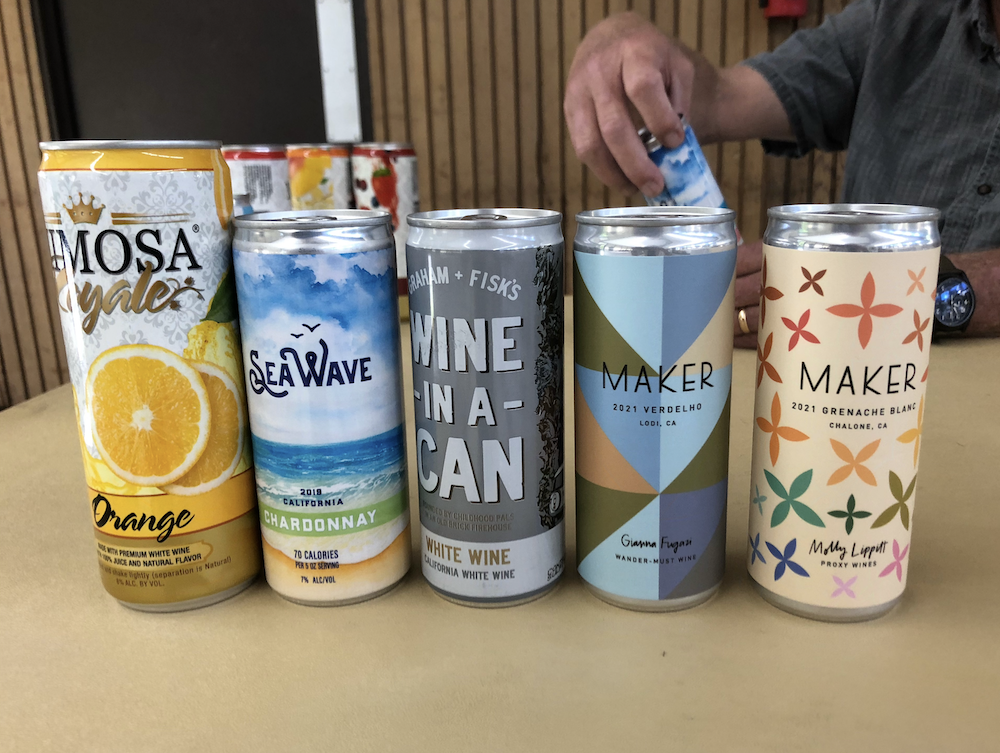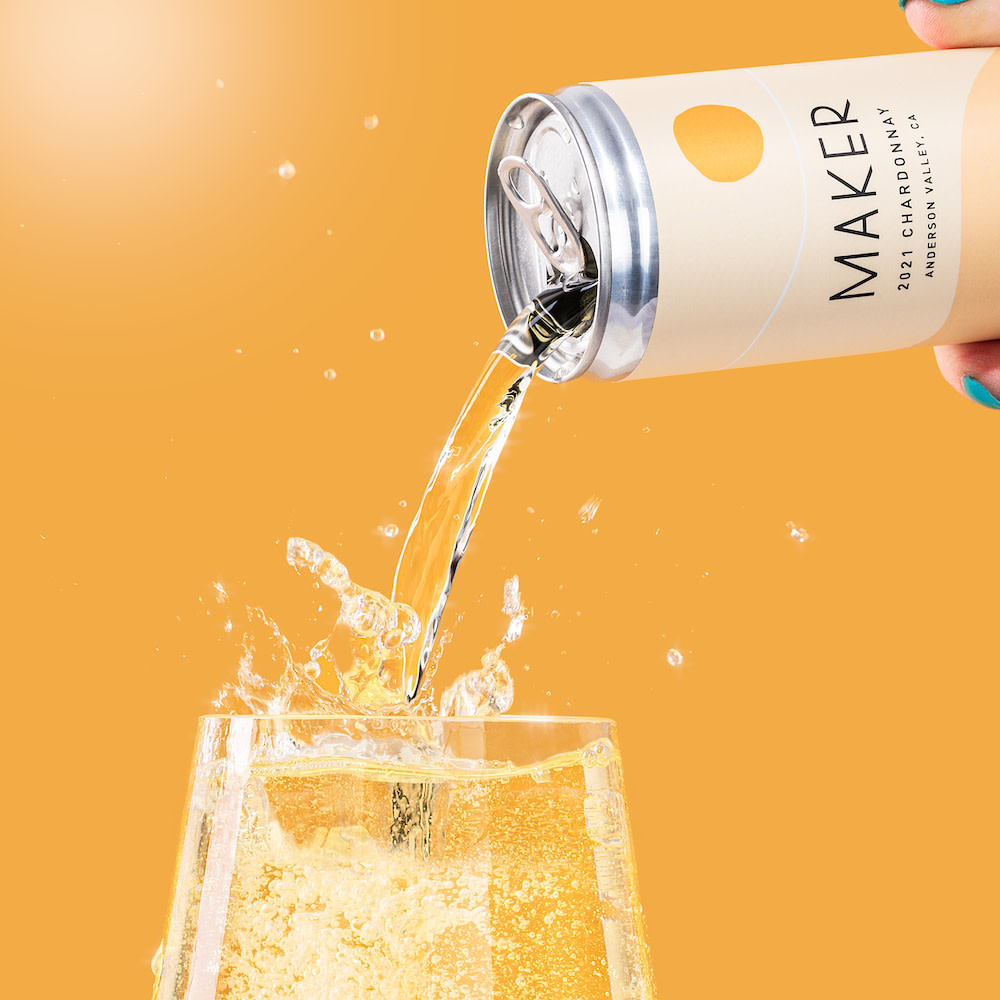
August 5, 2022 – Canned wines are becoming more of a thing in the wine industry. It’s a category that is growing by over 10% each year, which is pretty healthy. All the big players are jumping in, but I wouldn’t necessarily follow their breadcrumbs into the forest.
There are a few things you need to know about cans. Wine is acidic, and cans and acid are like Pelosi and McCarthy stuck in an elevator. Wine has to be specially treated in order to place it in a can and not have it go oxidative (too much O2) or reductive (too much sulfur, aka SO2). Canned wines tend to have a shelf life of less than 5 months, unless they are canned really carefully. The temperature they are stored at, much like wine in a bottle, impacts their longevity. So you have to be really careful when making your selections.
There are some rules that need to be followed when canning wine. It has to have a pH of 3 or higher, and total SO2 less than 80 ppm. The less sulfur the better for wines with pH under 3.5, which is typical of white wines. There are other rules regarding dissolved oxygen, copper and chlorides, which are things I am not sure I want in my wine anyway. Most canned wines, especially the sparkling or roses, tend to have a lot of CO2, which gives them that spritzy fizz when you pop them open. We’re conditioned to have a fizzy association with things in cans, thanks to beer and soda.
From a consumer standpoint, there are two really critical factors here: what type of can and at what temperature the canned wine has been stored. Only the 250ml and 375ml cans come with the option of a special plastic coating. You want that. The coating prevents the bad interaction of wine and can interior. The smaller the can, the better: less surface area where wine meets can.
Cellar temp is about 48 degrees, whereas grocery store shelves average about 68. Your average liquor or package store is likely even warmer.
So what’s the upshot? Buy canned wines directly from someone who specifically makes small amounts of product and sends it directly to you. One of those companies is Maker. Their model is to find winemakers with good products and stories—there are lots of women and minorities on their roster—and help them get those products into cans.

I’ve been fans of Maker products from the first time I tasted Nicole Walsh’s Ser 2020 Grenache Rosé from the Loma del Rio Vineyard, which is in King City, and managed by Monterey Pacific (Steve McIntyre). It was head and shoulders better than anything else I’d had in can prior. When she told me the story of how the Maker gals (Sarah Hoffman, Kendra Kawala, and Zoe Victor) had done their research on best practices when it comes to canning (and they are constantly refining as they learn) plus the fact they have their own canning line which they send directly to the winery to put the product up, I was intrigued.
I started tasting a variety of the Maker wines and discovered they were really excellent. We awarded a Viognier from Maker a Gold medal at the Press Democrat North Coast wine Challenge in 2021 and every subsequent competition has shown their wines to be consistent top performers. If you start with good wine, and can it properly, you will have a good product to deliver.
This year, when I got to judge the 4th Annual International Canned Wine Competition (held in Boonville – a great getaway for wine lovers, being in Anderson Valley) for the first time in mid-July, I was pretty blown away by the variety of cans and products people are putting in them. We had 300 wines from all over the globe, including from South Africa, New Zealand, Japan and Germany. This is a booming business, and will only become more so as wineries appreciate the carbon footprint of cans vs. glass, and the fact that recycling cans is way more common and successful than bottles.

But back to the canned wines. Some were quite lovely. Others, abysmal. Others serve no earthly purpose that has yet to dawn on me. We don’t need to talk about those dreadful carbonated whites or the low/no alcohol swill. Please, no.
Instead, let’s recognize the winning canned wines in their respective categories:
- Maker Wines 2021 Chardonnay from Handley Cellars, Anderson Valley, California
- Djuce Wines 2021 Rosé, Famille Chaudié, Provence, France
- Joiy 2018 The Gryphon Pinot Noir, Central Otago, New Zealand
- The OBC Wine Project Rosé with Bubbles, American
- Riot Wine Co. Rosé Spritz, South Australia
Getting your hands on the Handley Chardonnay, the first of this varietal they’ve made at Maker, but not the first wine from Handley that they’ve canned, will be far easier than anything else on this list. That winning canned Pinot Noir from NZ was really good, but the 2021 Maker Handley Pinot Noir, Anderson Valley, was slightly more fruity and round. You’ll like it a lot. The Joiy from New Zealand is definitely more of a lean, savory and acid driven style. One of my panel mates was from the Netherlands and clearly preferred that more linear style.
In this competition, we have two choices: award a wine a Gold medal or give it nada. It’s a harsh thumbs up or thumbs down verdict reminiscent of the Roman gladiator games. Out of 300 wines, there were 97 Gold medal winners: a fairly typical percentage. Among them was Nicole Walsh’s Ser Sparkling Riesling from Wirz Vineyard. It is utterly delightful, with just the perfect kiss bubbles, and the idea of capturing a piece of the history of this stunning vineyard in a can is pretty cool. In fact, the San Benito AVA, where Wirz Vineyard lies, is celebrating its 50th anniversary this year, so buy a six-pack of these cans and celebrate.
I also discovered a really cool Grenache Blanc at this competition, also from Maker, made by winemaker, Molly Lippitt, of Proxy Wines. She told me she had connected with the Maker gals last year and they hooked her up with grower Michael Michaud, whose vineyard lies in the white sands of Chalone, looking up at the Pinnacles.

“That project was really fun,” Lippitt told us. “It was my first venture with canning wine and I loved working with the Maker team. 2021 was my first vintage with Maker: we connected over the summer and pulled the Grenache Blanc program together sort of last minute. The grapes for that wine were from the Michaud vineyard. I loved working with his GB. It’s a grape I know so well and seeing the Chalone AVA through that familiar lens was just lovely.” Highly recommended.
It’s worth exploring all the Maker wines in cans, including Nicole Walsh’s Sparkling Riesling and Cabernet Pfeffer, the Verdelho from Wander-Must Wines, the Proxy Chalone Grenache Blanc and the Pinot Noir from Handley Cellars. You can order them from makerwines.com and they’ll ship them to you in the coolest boxes. The packaging is just fantastic. They have a can club which would make the perfect gift for wine lovers who live in places where good wines are hard to find. You can also get Ser’s canned wines at the Ser tasting room in Aptos. Great for those summer days on the beach, boating, backpacking or hiking in one of our fabulous local parks, including Big Basin, which is now open for day use, by reservation.
Each of the Maker cans holds 1/3 of a bottle: just about the perfect serving, with no muss, no fuss, no breakage and no worries of encountering cork taint. But go ahead and pour it into a glass, because you can.
About the author
Laura Ness is a longtime wine journalist, columnist and judge who contributes regularly to Edible Monterey Bay, Spirited, WineOh.Tv, Los Gatos Magazine and Wine Industry Network, and a variety of consumer publications. Her passion is telling stories about the intriguing characters who inhabit the fascinating world of wine and food.
- Laura Nesshttps://www.ediblemontereybay.com/author/lness/
- Laura Nesshttps://www.ediblemontereybay.com/author/lness/
- Laura Nesshttps://www.ediblemontereybay.com/author/lness/
- Laura Nesshttps://www.ediblemontereybay.com/author/lness/


